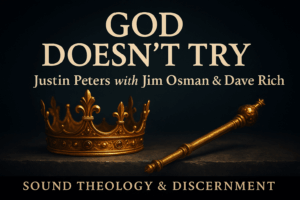⏱️ Estimated Reading Time: 6 min read
The past five to ten years have seen the resurgence of a great many doctrinal and theological topics. Among those topics is biblical theology—the discipline of understanding how the Bible recounts a single story- one that began at creation, encompasses people’s lives today and will continue under Christ’s return and beyond. Recently biblical scholar Dr. James M. Hamilton wrote What is Biblical Theology? A Guide To The Bible’s Story Symbolism, and Patterns. While Dr. Hamilton is an Associate Professor at The Southern Baptist Theological Seminary he is also a Pastor at Kenwood Baptist Church in Louisville Kentucky.
What is Biblical Theology? is divided into three parts. In part one Hamilton explores the Bible’s big story through the narrative, plot: and mystery. Part two covers the Bible’s symbolic universe through discussing the use of symbols, imagery, typology and patterns. The book concludes with the Bible’s love story, the Bride of Christ, the church’s identity and setting, plot tension and its resolution.
The one aspect of this book that stood out the most to me (and trust me the whole book is excellent) but in particular I found it very interesting and helpful how Dr. Hamilton invites his readers into the biblical world. He says:
“I hope you will breathe the air of the Bible’s world, recognize it as the real Narnia and never want to leave. If this happens, you will come to inhabit the Bible’s story. My prayer is that its symbols and patterns will shape the way you view the world and that your understanding of the church’s place in story and symbol will make you know the richest of god’s inheritance in the saints (Eph. 1:18, the great power “he worked in Christ when he raised him from the dead” (:120), and the glory he displays in the church and in Christ Jesus forever (Eph. 3:21). In brief, I hope you will adopt the perspective of the biblical authors and that you will read the world from the Bible’s perspective, rather than reading the Bible from the world’s” (22-23).
Dr. Hamilton’s other book God’s Salvation Through Judgment was extremely helpful to me. What is Biblical Theology was helpful in another way. While I’ve spent a lot of time over the past few years thinking about the doctrine of Scripture and trying to think through this doctrine in the way Dr. Hamilton describes—what stood out the most was the way in which Dr. Hamilton invites his readers into the biblical world. While I often try to compare and contrast what the world thinks with what the Bible says—what Dr. Hamilton does is to show the superiority of what the Bible’s story is in order to show why the Bible’s perspective is greater than the world. While my approach and Dr. Hamilton’s are different, I agree with Dr. Hamilton and am persuaded that the way he describes the Bible’s world is greater than just comparing and contrasting what the world believes and thinks. As Christians we have a Word from God that is far greater than the world’s teaching. The Bible is God’s inspired, inerrant, authoritative and sufficient Word to His people. The invitation to come and read the “Word from the biblical perspective rather than reading the Bible from the world’s” is paradigm altering for several reasons.
First, many people come to the Bible to answer their questions; rather than coming to the Bible to hear, heed and obey what God has said. The difference here is huge and to be fair there is not enough space in this review to get into it all—other than to say when we truly go into and are captivated by the world of the Bible—we truly will never go back because we have fallen in love with the God of the Word who has given His people a Word about Himself. Ultimately that should be the goal of Bible study—to not just read information but to gain heart knowledge. After all to the Jews knowledge was not just in the head but also in the heart so a life that has been affected by the Bible is one that loves God with all of one’s heart, mind and strength. This is precisely why we need books like What is Biblical Theology by Dr. James Hamilton. Dr. Hamilton writes not only as a world class biblical theologian but as a pastor-theologian to help the people of God understand what the issue is and why it is so important.
Writers seek to persuade their audience they are right about what they write about as well as to strength their readers understanding of the topic. Dr. Hamilton not only accomplishes those two goals—he marvelously exceeds them. While God’s Salvation in Judgment is a much longer book—What is Biblical Theology is a very short book at 118 pages that sets forth to explain what biblical theology is taking as its source the Bible itself—tracing its story from beginning to end in an engaging, thoughtful and pastoral way that will help lay people and any student of the Bible to grasp what the author is teaching. In other words, What is Biblical Theology will help you to love Jesus more by helping you understanding your Bible better. While there are many books that you could read I hope and pray you will pick up What is Biblical Theology because there is nothing more important than understanding the storyline of Scripture and why it matters to you. This book will help you to understand that the Bible has one story—one that began at creation, encompasses our lives today and will continue until Christ’s return and beyond. Pick up What is Biblical Theology and learn to understand the worldview of the biblical writers so you can read the Old and New Testaments as those authors intended. This book will help you not just understand the Bible better but to find your place within the grand story of redemption.
Title: What Is Biblical Theology?: A Guide to the Bible’s Story, Symbolism, and Patterns
Author: James M. Hamilton Jr.
Publisher: Crossway (2013)
I received this for free from Crossway book review program for this review. I was not required to write a positive review. The opinions I have expressed are my own. I am disclosing this in accordance with the Federal Trade Commission’s 16 CFR, Part 255 : “Guides Concerning the Use of Endorsements and Testimonials in Advertising.”



